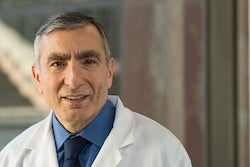HOUSTON – (Jan. 24, 2021) – More than 20 years ago, Wired featured Rice University chemist James Tour in a story about molecular electronics, then a focus of his lab. At the time, he said commercializing single molecules turned into circuits was perhaps three to five years away.
“I was only off by an order of magnitude,” Tour says now after assisting a California company, Roswell Biotechnologies, in fabricating semiconducting sensors using single molecules as the key component.
The work is the focus of a new paper in the Proceedings of the National Academy of Sciences. Tour is a co-author and science adviser to the company that largely produced the paper and, in mid-November, introduced its scalable chips to measure biological binding kinetics and enzyme activity.
“I’m happy that Rice is associated with the first commercialization of a molecular electronic chip where you have a single molecule acting as a device,” Tour said. “Each device on the chip is based on a single-molecule phenomenon. This is not an array of thousands of molecules doing a singular function, it is single molecules doing functions. That’s the distinguishing difference.”
Molecular electronics, aka moletronics, could extend the reach of Moore’s law (which states the number of transistors in an integrated circuit doubles every two years) through chips that incorporate circuits at the nanometer scale.
The San Diego company’s general-purpose sensors employ single synthetic molecular wires that span 20-nanometer gaps between electrodes and are programmed to change the picoamp current they carry when they interact with a molecular target, like an enzyme. The chips report what they find in real time and without the need for fluorescent tags.
“This will enable all sorts of biological assays, but other things they could enable are decoding the human genome more quickly and even enabling DNA for use as a data storage device,” Tour said.
Tour certainly has a good overview of the discipline, having started work on molecular electronics in 1988 while at the University of South Carolina. “One of my first papers was on a molecular electronics switch,” he said. “Mark Reed and I were the ones who devised the interface method of single molecules with metal surfaces for electronic contact and single-molecule device measurements, so it’s good to see this work is really translating now to commercial embodiments.”
Image for download:

https://news-network.rice.edu/news/files/2021/12/1220_TOUR-1-web.jpg
CAPTION: James Tour. (Credit: Jeff Fitlow/Rice University)
Located on a 300-acre forested campus in Houston, Rice University is consistently ranked among the nation’s top 20 universities by U.S. News & World Report. Rice has highly respected schools of Architecture, Business, Continuing Studies, Engineering, Humanities, Music, Natural Sciences and Social Sciences and is home to the Baker Institute for Public Policy. With 4,052 undergraduates and 3,484 graduate students, Rice’s undergraduate student-to-faculty ratio is just under 6-to-1. Its residential college system builds close-knit communities and lifelong friendships, just one reason why Rice is ranked No. 1 for lots of race/class interaction and No. 1 for quality of life by the Princeton Review. Rice is also rated as a best value among pr

